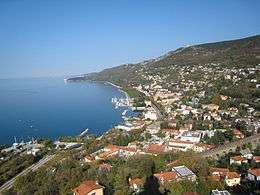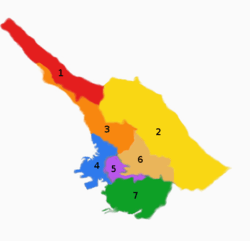Barcola
Barcola is a maritime neighbourhood of Trieste, Italy. It is a popular tourist place with beaches and long promenade walkways, near to the Habsburg-established Miramare Castle.
Barcola Barkovlje | |
|---|---|
Neighbourhood | |
 View of Barcola from the Vittoria Light. | |
 Sections of Trieste, Barcola is located in section 3 | |
 Barcola Sections of Trieste, Barcola is located in section 3 | |
| Coordinates: 45°40′46″N 13°45′16″E | |
| Country | Italy |
| Region | Friuli-Venezia Giulia |
| Municipality | Trieste |
| Population (2011) | |
| • Total | 2 801 |
| Area code(s) | 040 |
Barcola is highly valued for the high quality of life and living and the free access to the sea. The long and partly shady 5 km long waterfront of Barcola serves as a recreation area and city bathing beach of Trieste and is connected to the city center, Miramare, Sistiana but also partly to Grado by bus lines and regular shipping services. Barcola has several small ports, especially Porticciolo di Barcola, where local professional fishermen also work and liner shipping operates.
Known in Roman times as "Vallicula" or later as "Valcula", it is known for its exclusive houses, the view from the green hills of the Gulf of Trieste, its long coastal promenade with extensive bathing and sports facilities and its hedonistically relaxed sporty mood. It is often referred to as the Adriatic Malibu.[1]
Geography
The karst plateau of the Trieste coastal region, on the edge of which is Barcola, is also considered the foothills of the Alps.[2] Barcola is reached from the centre of Trieste by taking viale Miramare in the direction of Venice. Barcola is about 3 km from the train station.
At the end of the 19th century, in Barcola, between the cemetery and the San Bartolomeo church, at about Viale Miramare 48, the remains of a magnificent Roman villa by the sea, worthy of a prince, were discovered. This complex of buildings, now known as Villa Maritima of Barcola, with a first construction phase in the second half of the 1st century BC, stretched along the coast and was divided into terraces into a representation area in which luxury and power were displayed, a separate one Living area, a garden, some facilities open to the sea and a thermal bath. Extensions and renovations can be dated to the second half of the 1st century AD. The works of art and mosaics found are now in the Lapidario Tergestino Museum in the San Giusto Castle, although comparable works can only be found in Rome and Campania.
_Il_Lungomare_005.jpg)
In 1886 the Excelsior lido, which still exists today, was founded, followed by rowing clubs and other beach establishments, some of which still exist. The history of this model for many beach resorts began in 1886 when the Di Salvore family, who owned land in Barcola, received the concession to use the area around the former Roman Villa Maritima of Barcola. In 1890, the architect Edoardo Tureck was commissioned by Alessandro Cesare di Salvore, a shipowner, city councilor and theater director, to build a bathing facility at the natural sandbar, and in 1895 the hotel of the same name was also built across the street. The then well-known and flourishing bathhouse Excelsior, which passed on to other owners in the following years, was expanded several times, so in 1909 a small theater and a restaurant were integrated. According to a local story, the world champion in underwater fishing Claudio Martinuzzi learned in the 1980s at the Excelsior lido to swim. The beach complex, located on a historic Roman soil, has been converted into apartments or bath huts with a unique sandy beach in Trieste. A unique peculiarity for Italy is that due to the unique overlap of Habsburg and Italian law in the area of this historic beach complex, the beach is not public state property, but private property.
Above Barcola in Gretta is the lighthouse Vittoria Light, which was built from 1923 to 1927 on the former k.u.k. fortification Kressich as a substructure. This fortification has various underground rooms and tunnels, protected from artillery attacks, all the way to Barcola. The lighthouse is one of the tallest lighthouses in the world.[3]
In 1928 the Strada Costiera, which leads from Barcola to Sistiana, was opened. According to a ranking by the WTO (World Organization for Tourism), this part of the connecting road from Trieste to Venice is one of the most beautiful coastal roads in the world because of its panoramic views.[4]
In the 1950s, the Pineta area was heaped up. The "Pineta di Barcola", with its 25,400 square meters of pine forest, today houses numerous bars and sports areas for bathers. Until 1969, Barcola was connected to the center by tram line 6. In addition to many villas in rich Trieste, the building at Viale Miramare 229 with its distinctive onion turrets is particularly eye-catching. This villa, the Casa Jakic, dates from 1896 and initially belonged to a Russian Orthodox priest who was said to be a tsar spy and was later used as an arcade and brothel.
The beach, the promenade and the pine forest of Barcola, all classic resorts of the Trieste, are particularly busy in summer. Claudio Magris bathed here as a child with his mother. The extensive redesign of the waterfront with the paving made of porphyry stones and sandstone slabs took place in the years 2000 to 2001. The ten popular semicircular building blocks on the shore, consisting of a viewing platform, sanitary facilities and changing rooms, are popularly known as Topolini (plural of the Walt Disney character "Mickey Mouse"- because of the characteristic shape from above). There is a wide range of restaurants and extensive parking spaces.
The experiences and stories of the local captains, skippers and fishermen from Trieste and Barcola (with their stories in local bars such as Skipper Point) are recorded by the author Paolo Rumiz in his book "Il Ciclope".
Culture
.jpg)
Barcolana regatta
It is best known for the Barcolana regatta, a European sailing race that happens every year in October.
Slovenes
According to the last Austro-Hungarian census of 1911, more than 73% of the population of the suburb were of Slovene ethnicity.[5] After the annexation to Italy in 1920, the percentage of Slovene speakers fell significantly; however, Barcola is still an important center of the Slovene minority in Italy. Traditionally, the Karst dialect of Slovene has been spoken in Barcola, differently from most other ethnic Slovene villages around Trieste, where the Inner Carniolan dialect is spoken. It is known as 'Barkovlje' in Slovene.
References
- Mauro Covacich "Triest verkehrt: Fünfzehn Spaziergänge in der Stadt des Windes" (2012), p 93.
- Das Triestiner Küstengebiet (German)
- Rowlett, Russ. "The Tallest Lighthouses". The Lighthouse Directory. University of North Carolina at Chapel Hill.
- Kofler/Bettschart: Triest. 2015, p 104.
- Spezialortsrepertorium der österreichischen Länder. Bearbeitet auf Grund der Ergebnisse der Volkszählung vom 31. Dezember 1910, vol. 7: Österreichisch-Illyrisches Küstenland. Vienna: K. k. Hof- und Staatsdruckerei. 1918. p. 3.
| Wikimedia Commons has media related to Barcola. |